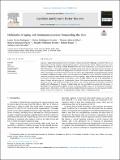| dc.contributor.author | Perim Rodrigues, Leane | |
| dc.contributor.author | Rodrigues Teixeira, Vitória | |
| dc.contributor.author | Alencar-Silva, Thuany | |
| dc.contributor.author | Simonassi-Paiva, Bianc | |
| dc.contributor.author | Wellerson Pereira, Rinaldo | |
| dc.contributor.author | Pogue, Robert | |
| dc.contributor.author | Lott Carvalho, Juliana | |
| dc.date.accessioned | 2023-01-17T15:06:46Z | |
| dc.date.available | 2023-01-17T15:06:46Z | |
| dc.date.copyright | 2022 | |
| dc.date.issued | 2022-06 | |
| dc.identifier.citation | Perim Rodrigues, L., Rodrigues Teixeira, V., Alencar-Silva, T., Simonassi-Paiva, B., Pereira, R.W., Pogue, R., Lott Carvalho, J. (2022). Hallmarks of aging and immunosenescence: connecting the dots. Cytokine and Growth Factor Reviews. 59, 9-21. | en_US |
| dc.identifier.issn | 1359-6101 | |
| dc.identifier.uri | https://research.thea.ie/handle/20.500.12065/4365 | |
| dc.description.abstract | Aging is a natural physiological process that features various and variable challenges, associated with loss of homeostasis within the organism, often leading to negative consequences for health. Cellular senescence occurs when cells exhaust the capacity to renew themselves and their tissue environment as the cell cycle comes to a halt. This process is influenced by genetics, metabolism and extrinsic factors. Immunosenescence, the aging of the immune system, is a result of the aging process, but can also in turn act as a secondary inducer of senescence within other tissues. This review aims to summarize the current state of knowledge regarding hallmarks of aging in relation to immunosenescence, with a focus on aging-related imbalances in the medullary environment, as well as the components of the innate and adaptive immune responses. Aging within the immune system alters its functionality, and has consequences for the person's ability to fight infections, as well as for susceptibility to chronic diseases such as cancer and cardiovascular disease. The senescence-associated secretory phenotype is described, as well as the involvement of this phenomenon in the paracrine induction of senescence in otherwise healthy cells. Inflammaging is discussed in detail, along with the comorbidities associated with this process. A knowledge of these processes is required in order to consider possible targets for the application of senotherapeutic agents - interventions with the potential to modulate the senescence process, thus prolonging the healthy lifespan of the immune system and minimizing the secondary effects of immunosenescence. | en_US |
| dc.format | PDF | en_US |
| dc.language.iso | eng | en_US |
| dc.publisher | Elsevier | en_US |
| dc.relation.ispartof | Cytokine and Growth Factor Reviews | en_US |
| dc.rights | Attribution-NonCommercial-NoDerivs 3.0 United States | * |
| dc.rights.uri | http://creativecommons.org/licenses/by-nc-nd/3.0/us/ | * |
| dc.subject | Aging | en_US |
| dc.subject | Senescence | en_US |
| dc.subject | Immunosenescence | en_US |
| dc.subject | Inflammaging | en_US |
| dc.subject | Senotherapeutics | en_US |
| dc.title | Hallmarks of aging and immunosenescence: connecting the dots | en_US |
| dc.type | info:eu-repo/semantics/article | en_US |
| dc.contributor.affiliation | Technological University of the Shannon: Midlands Midwest | en_US |
| dc.contributor.sponsor | Conselho Nacional de Desenvolvimento Científico e Tecnologico (CNPq) and Fundaçao de Amparo `a Pesquisa do Distrito Federal (FAPDF). | en_US |
| dc.description.peerreview | yes | en_US |
| dc.identifier.doi | 10.1016/j.cytogfr.2021.01.006 | en_US |
| dc.identifier.eissn | 1879-0305 | |
| dc.identifier.endpage | 21 | en_US |
| dc.identifier.orcid | https://orcid.org/0000-0002-8486-1275 | en_US |
| dc.identifier.orcid | https://orcid.org/0000-0002-8789-3512 | en_US |
| dc.identifier.startpage | 9 | en_US |
| dc.identifier.volume | 59 | en_US |
| dc.rights.accessrights | info:eu-repo/semantics/openAccess | en_US |
| dc.subject.department | Bioscience Research Institute TUS: Midlands | en_US |
| dc.type.version | info:eu-repo/semantics/publishedVersion | en_US |


